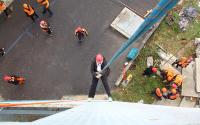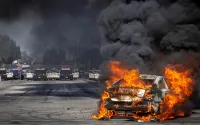13 October 2005Bill McKibben
Forget about the hurricanes. Put them out of your mind. We'll never know for sure that any particular hurricane is caused by global warming, so just don't think about them. Instead, concentrate on the other evidence for climate change that's appeared recently:
In August, Russian researchers reported that an area of tundra larger than France and Germany combined was rapidly turning into bog as the permafrost melted.
In early September, British researchers reported that warmer temperatures were causing the soil to heat up and dramatically increasing rates of decay. The temperate forests and fields of the United Kingdom are becoming, in essence, semitropical.
In mid-September, researchers reported that arctic sea ice had shrunk by 20 percent. "The feeling is we are reaching a tipping point or threshold beyond which sea ice will not recover,"one scientist told reporters.
And in late September, European researchers reported on the biological effects of 2003's record heat wave, the one that killed 15,000 people in France alone. In Italy, they said, corn yields dropped by about 36 percent. Oak and pine also grew more slowly, the study found. In fact, overall there was 30 percent less plant growth that year.
What do numbers like these -- all from the best peer-reviewed journals -- show us? That global warming is not some distant problem waiting to appear, some hypothetical trouble we should start preparing for. They show us that the world is already changing with deadly speed. Every time we burn coal and gas and oil, we send carbon dioxide into the atmosphere, and now that carbon dioxide is trapping enough heat to create a new planet.
And what's really scary is that each of these developments will in turn trigger more global warming. They're what scientists call feedback loops. For instance, as the Siberian permafrost melts it releases huge quantities of methane -- at some spots last winter the gas was bubbling up so fast that the bogs didn't freeze in even the coldest weather. And methane is an even more potent greenhouse gas than carbon dioxide.
Meanwhile, as British soils heat and decay speeds up, that decay releases carbon -- enough to offset all the energy-saving changes that Britain has made since 1990. Meanwhile the reductions in plant growth that the Europeans found during the hot summer of 2003 mean fewer trees and plants to soak up the carbon from the atmosphere.
And up north? White sea ice reflects the sun's rays back to space; when it melts to blue water that heat is now absorbed, increasing warming yet again.
So far human beings have increased the planet's temperature about 1 degree Fahrenheit. Unless we do everything possible, as quickly as possible, to shift away from fossil fuels, scientists say we will warm the planet another 5 degrees before the century's end. So imagine all those numbers multiplied by five.
It's about time for denial to come to an end. We're no longer talking about theory, about computer models of what might happen. We're talking about what is happening, all around the world, with almost unimaginable speed. Other countries have at least begun to try to deal with the problem, implementing small first steps like the Kyoto Protocol. But here in the United States, there's only a scattering of state and local measures. Washington is governed by a bipartisan consensus that somehow the laws of physics and chemistry don't apply to us.
But they do. I said I wasn't going to talk about the hurricanes, but I lied. In early August a paper by a Massachusetts Institute of Technology researcher in the journal Nature showed that hurricanes were 50 percent stronger and lasted 60 percent longer than a generation ago. In early September a Georgia Tech team showed that the number of category 4 and 5 storms had doubled. You've seen the results on every TV screen and magazine cover.
Exactly how much more do we need to know? Exactly when are we going to roll up our sleeves and get to work?
Bill McKibben is a scholar in residence in environmental studies at Middlebury College and the author of The End of Nature. He wrote this essay for the Land Institute's Prairie Writers Circle, Salina, Kan.






